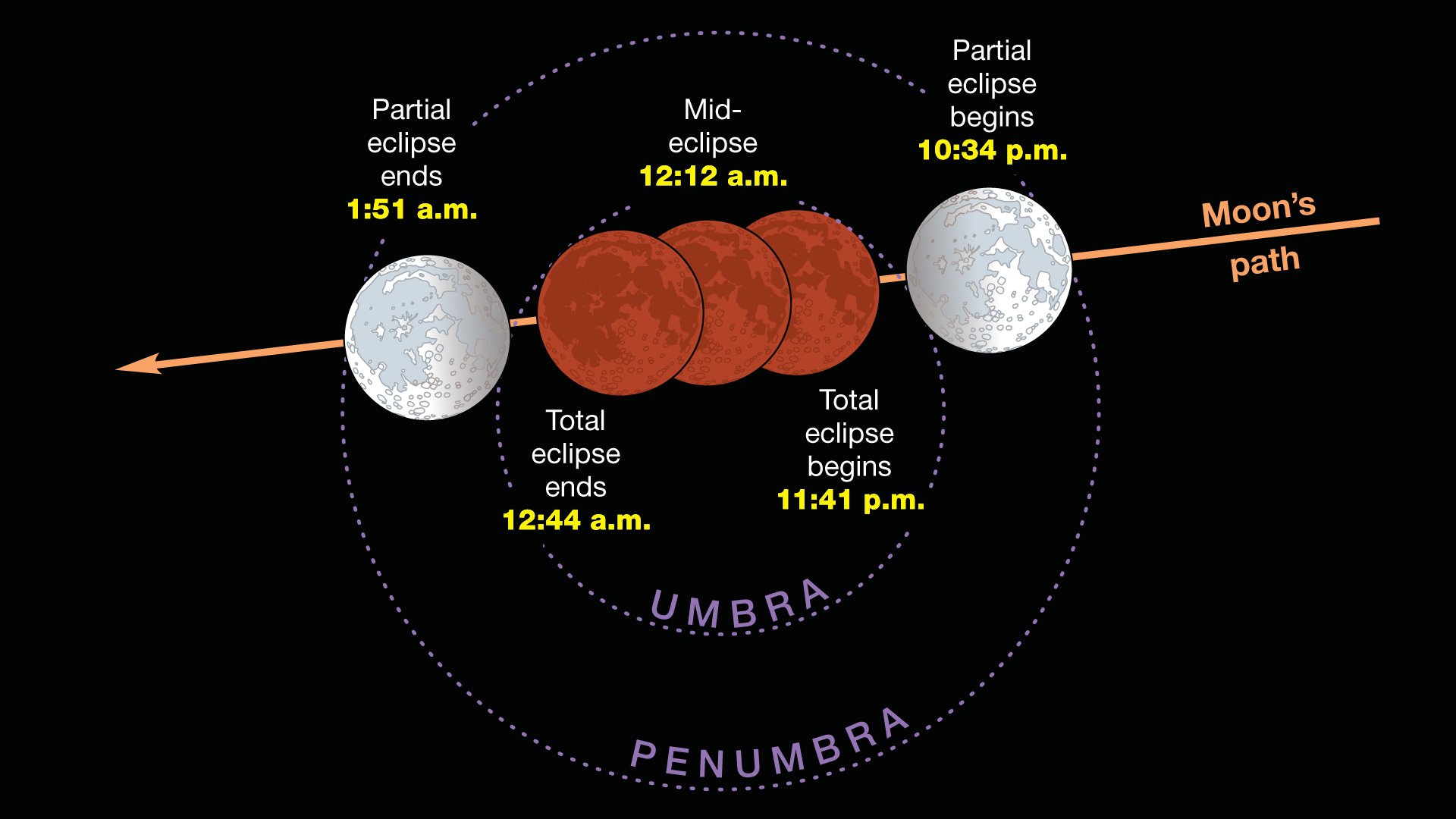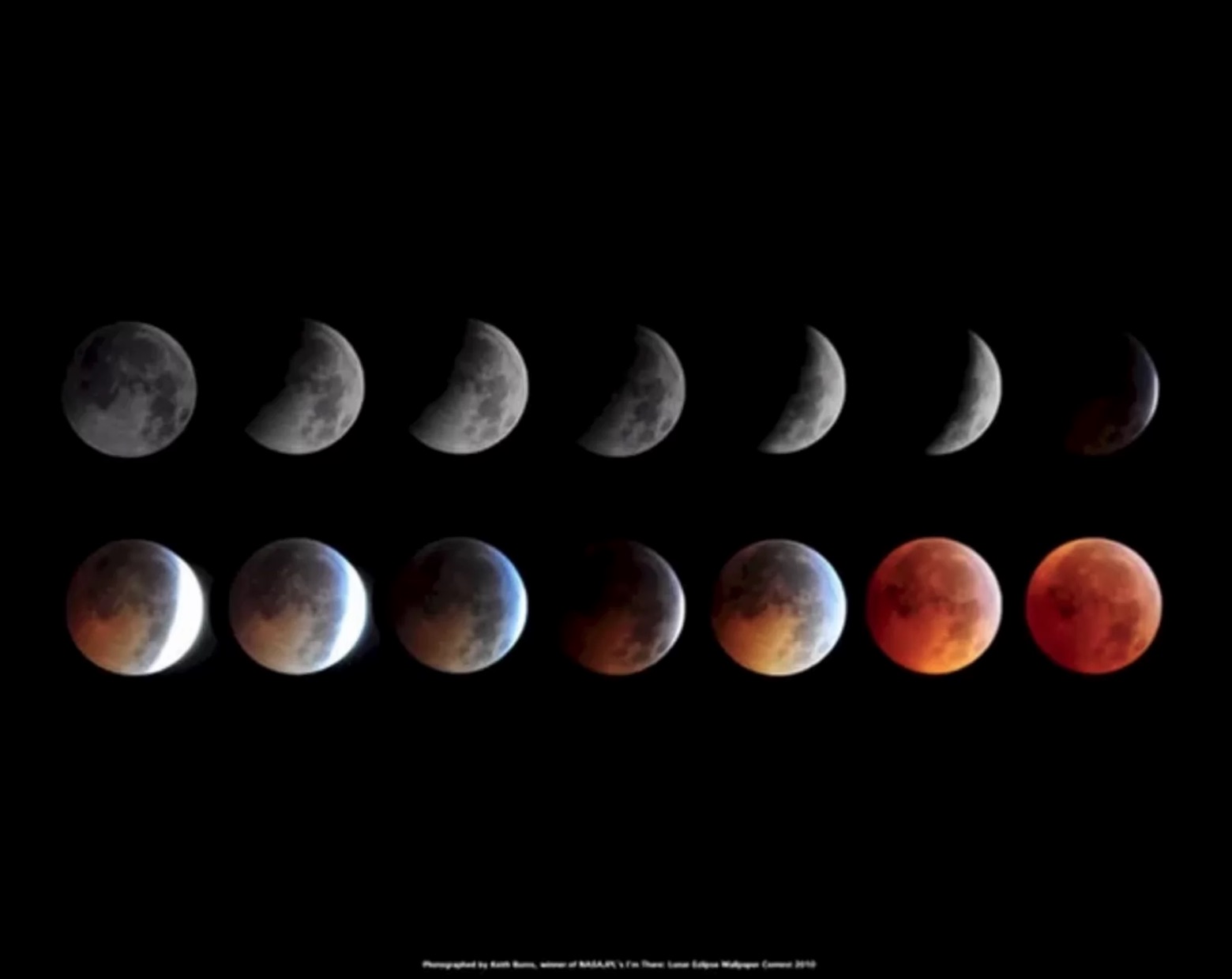The Stages of the Super Blood Moon Lunar Eclipse of 2019 Explained!
No avid skywatcher ever misses a total eclipse of the moon (weather permitting, of course). This celestial pageant is often more beautiful and interesting than one would think. During the time that the moon enters into and later emerges from the Earth's shadow, interesting secondary phenomena appear, and you don't want to overlook them.
To help prepare for the upcoming eclipse of Jan. 20-21, Space.com's Joe Rao — a veteran of 18 total lunar eclipses — has prepared a chronology listing some of the things you may see. Probably not all of the stages mentioned will occur, however, because no two eclipses are exactly the same.
But many of the stages will occur, and people who know what to look for have a better chance of seeing them! [Supermoon Blood Moon Total Lunar Eclipse: Complete Guide]
| 1 | 2:36 | 10:36 | 9:36 | 8:36 | 7:36 | 6:36 | —— | —— |
| 2 | 3:16 | 11:16 | 10:16 | 9:16 | 8:16 | 7:16 | 6:16 | —— |
| 3 | 3:33 | 11:33 | 10:33 | 9:33 | 8:33 | 7:33 | 6:33 | —— |
| 4 | 4:24 | 12:24 | 11:24 | 10:24 | 9:24 | 8:24 | 7:24 | 6:24 |
| 5 | 4:36 | 12:36 | 11:36 | 10:36 | 9:36 | 8:36 | 7:36 | 6:36 |
| 6 | 4:41 | 12:41 | 11:41 | 10:41 | 9:41 | 8:41 | 7:41 | 6:41 |
| 7 | 5:13 | 1:13 | 12:13 | 11:13 | 10:13 | 9:13 | 8:13 | 7:13 |
| 8 | 5:43 | 1:43 | 12:43 | 11:43 | 10:43 | 9:43 | 8:43 | 7:43 |
| 9 | 6:00 | 2:00 | 1:00 | 12:00 | 11:00 | 10:00 | 9:00 | 8:00 |
| 10 | 6:50 | 2:50 | 1:50 | 12:50 | 11:50 | 10:50 | 9:50 | 8:50 |
| 11 | 7:07 | 3:07 | 2:07 | 1:07 | 12:07 | 11:07 | 10:07 | 9:07 |
| 12 | 7:48 | 3:48 | 2:48 | 1:48 | 12:48 | 11:48 | 10:48 | 9:48 |
The above timetable lists local circumstances for eight different time zones. All times are for p.m. on Jan. 20, except when in italics, which correspond to a.m. on Jan. 21. Dashes mean that the moon has not yet risen above the horizon.
The various stages fully described:
1) Moon enters penumbra — The shadow cone of the Earth has two parts: a dark, inner umbra, surrounded by a lighter penumbra. The penumbra is the pale outer portion of the Earth's shadow. Although the eclipse begins officially at the moment Earth enters the penumbra, this is an academic event. You won't see anything unusual happening to the moon — at least not yet. The Earth's penumbral shadow is so faint that it remains invisible until the moon is deeply immersed in it. We must wait until the penumbra has reached roughly 70 percent across the moon's disk. For about the next 40 minutes, the full moon will continue to appear to shine normally, although with each passing minute, it is progressing deeper into the Earth's outer shadow.
2) Penumbral shadow appears — Now, the moon has progressed far enough into the penumbra that this shadow should be evident on the moon's disk. Look for a very subtle shading to appear on the moon's left portion. This will become more and more evident as the minutes pass; the shading will appear to spread and deepen. Just before the moon enters the Earth's dark umbral shadow, the penumbra should appear as an obvious smudge or tarnishing of the moon's left portion.
3) Moon enters umbra — The moon now sets off across the Earth's dark central shadow, called the umbra. A small, dark scallop appears on the moon's lower left-hand (southeastern) limb. The partial phases of the eclipse begin; the pace quickens, and the change is dramatic. The umbra is much darker than the penumbra and is fairly sharp-edged. As the minutes pass, the dark shadow appears to slowly creep across the moon's face. At first, the moon's limb may seem to vanish completely inside of the umbra, but much later, as the moon moves in deeper, you'll probably notice it glowing dimly orange, red or brown. Notice also that the edge of the Earth's shadow projected on the moon is curved. Here is visible evidence that the Earth is a sphere, as deduced by Aristotle from Iunar eclipses he observed in the 4th century B.C. Almost as if a dimmer switch were slowly being turned down, the surrounding landscape and deep shadows of a brilliant, moonlit night will fade away. [In Photos: The Rare Super Blue Blood Moon Lunar Eclipse]
Breaking space news, the latest updates on rocket launches, skywatching events and more!
For the Hawaiian Islands, moonrise comes shortly after 6 p.m. Hawaii time, when the moon will already be immersed roughly halfway into the umbra. The low, partially eclipsed moon in deep blue twilight should offer a wide variety of interesting scenic possibilities for artists and astrophotographers; a peculiar-looking, elongated crescent moon will appear to rise, cusps pointed down toward the east-northeast horizon.
4) 75 percent coverage — With three-quarters of the moon's disk now eclipsed, the part of it that is immersed in shadow should very faintly light up. It will look similar to a piece of iron heated to the point that it just begins to glow. It now becomes obvious that the umbral shadow is not in complete darkness. To viewers using binoculars or telescopes, the moon's outer portion is usually light enough to reveal lunar seas and craters, but the central part is much darker, and sometimes no surface features are recognizable. Colors in the umbra vary greatly from one eclipse to the next; reds and grays usually predominate, but sometimes browns, blues and other tints can be seen.
5) Less than 5 minutes to totality — Several minutes before (and after) totality, the contrast between the remaining pale-yellow sliver and the ruddy brown spread over the rest of the moon's disk may produce a beautiful phenomenon known to some as the Japanese lantern effect, a term coined by Long Island astrophotographer Peter A. Leavens in the 1950s.
6) Total eclipse begins — When the last part of the moon enters the umbra, the total eclipse begins. How the moon will appear during totality is not known. Some eclipses are such a dark gray-black that the moon nearly vanishes from view. In other eclipses, the moon can glow a bright orange. The reason the moon can be seen at all when totally eclipsed is that our atmosphere scatters and refracts sunlight around the edge of the Earth. To an astronaut standing on the moon during totality, the sun would be hidden behind a dark Earth outlined by a brilliant red ring consisting of all the world's sunrises and sunsets. The brightness of this ring around the Earth depends on global weather conditions and the amount of dust suspended in the air. A clear atmosphere on Earth means a bright lunar eclipse. If a major volcanic eruption has injected particles into the stratosphere during the previous couple of years, the eclipse is very dark. But as of this writing, no such eruption has happened since our last total lunar eclipse, in July 2018, so it's a safe bet that this eclipse will be relatively bright.
7) Middle of totality — The moon is now anywhere from 10,000 to 100,000 times fainter than it was just a couple of hours previously. Since the moon is moving to the north of the center of the Earth's umbra, the gradation of color and brightness across the moon's disk should make its lower portion appear darkest, with hues of deep copper or chocolate brown. Meanwhile, the moon's upper portion — that part closest to the outer edge of the umbra — should appear brightest, glowing with reds, oranges and even perhaps a soft bluish white.
Observers watching away from bright city lights will notice a much greater number of stars than were visible earlier in the night.
The moon will be the constellation of Gemini, the twins, with the entire retinue of bright winter stars and constellations spread out just to the west of the moon. The darkness of the sky is impressive. The surrounding landscape has taken on a somber hue. Before the eclipse, the full moon looked flat and one-dimensional. During totality, however, it will look smaller and three-dimensional — and almost translucent, like some weirdly illuminated ball suspended in space.
Before the moon entered the Earth's shadow, the temperature on the sunlit lunar surface hovered at 266 degrees Fahrenheit (127 degrees Celsius). Because the moon lacks an atmosphere, there is no way that this heat can be kept from escaping into space as the shadow sweeps by. Now, in shadow, the temperature on the moon has dropped to minus 146 degrees F (minus 99 degrees C). That's a drop of 412 degrees F (226 degrees C) in just over an hour!
8) Total eclipse ends — The emergence of the moon from the shadow begins. The first small segment of the moon reappears, followed again for the next several minutes by the Japanese lantern effect.
9) 75 percent coverage — Any vestiges of coloration within the umbra should be disappearing now. From here on, as the dark shadow methodically creeps off the moon's disk, that shadow should appear black and featureless.
10) Moon leaves umbra — The dark central shadow clears the moon's right-hand (western) limb.
11) Penumbra shadow fades away — As the last, faint shading vanishes off the moon's right portion, the visual show comes to an end.
12) Moon leaves penumbra — The eclipse "officially" ends, as the moon is completely free of the penumbral shadow.
Joe Rao serves as an instructor and guest lecturer at New York's Hayden Planetarium. He writes about astronomy for Natural History magazine, the Farmers' Almanac and other publications, and he is also an on-camera meteorologist for Verizon FiOS1 News in New York's lower Hudson Valley. Follow us on Twitter @Spacedotcom and on Facebook. Original article on Space.com.

Joe Rao is Space.com's skywatching columnist, as well as a veteran meteorologist and eclipse chaser who also serves as an instructor and guest lecturer at New York's Hayden Planetarium. He writes about astronomy for Natural History magazine, Sky & Telescope and other publications. Joe is an 8-time Emmy-nominated meteorologist who served the Putnam Valley region of New York for over 21 years. You can find him on Twitter and YouTube tracking lunar and solar eclipses, meteor showers and more. To find out Joe's latest project, visit him on Twitter.



